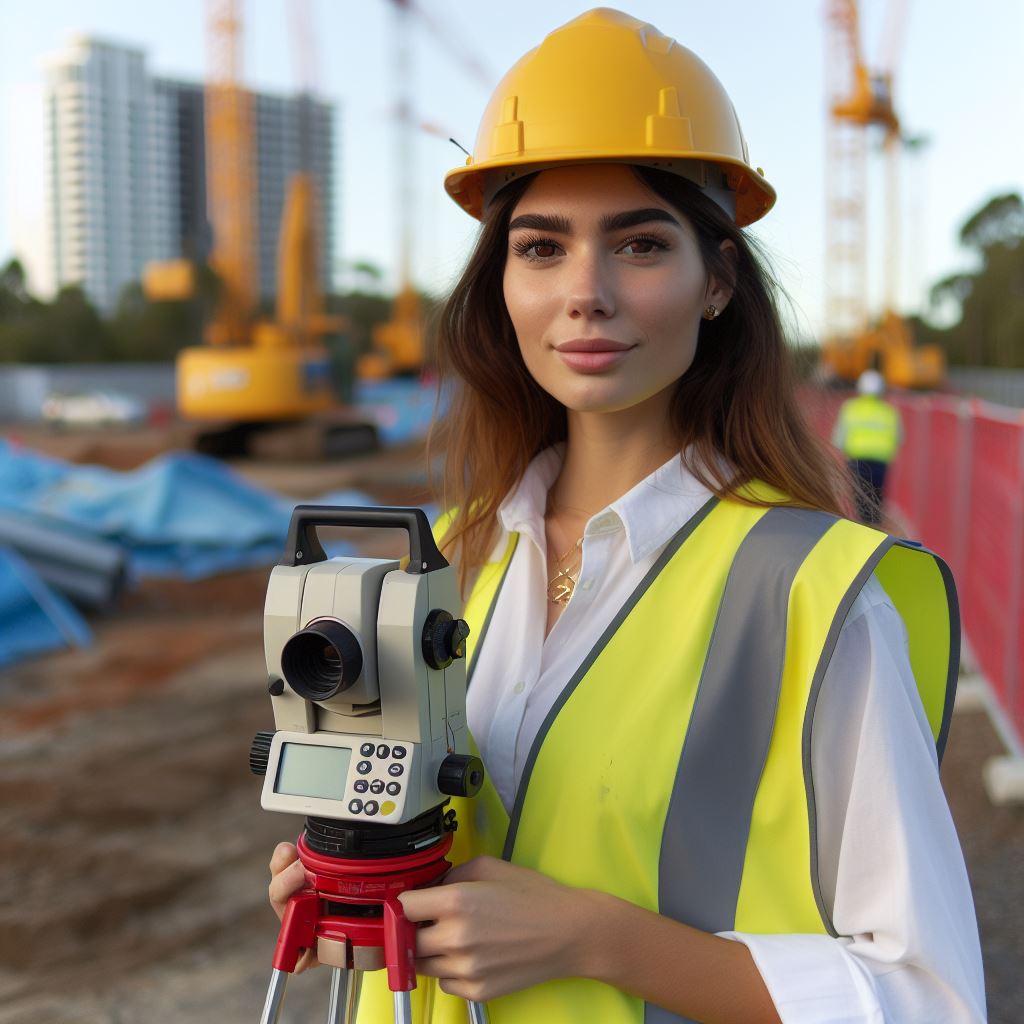Introduction
Emphasizing the paramount importance of surveyor safety practices is indispensable within the ever-evolving landscape of Australian surveying projects.
In the intricate world of land measurement, topography analysis, and data collection, prioritizing the well-being of surveyors becomes a cornerstone for successful project execution.
This section unfolds with a comprehensive overview, delving into the intricate details of safety measures essential for surveyors operating in Australia.
From the challenges posed by diverse terrains to the potential hazards associated with modern surveying equipment, a nuanced understanding of safety protocols is critical for the seamless functioning of surveying teams across the continent.
The purpose of this blog post extends beyond a mere enumeration of safety guidelines.
It aims to serve as an insightful guide, shedding light on the significance of each safety practice and fostering a culture of vigilance and preparedness among surveying professionals across Australia.
Overview of Surveyor Safety Practices
A. Definition of surveyor safety practices
Surveyor safety practices refer to a set of guidelines and protocols that surveyors in Australia follow to ensure their safety while performing their duties.
B. Key responsibilities of surveyors in Australia
- Accurate measurements: Surveyors have the responsibility to accurately measure and record data for various purposes, such as land development and construction projects.
- Evaluating boundaries: Surveyors are responsible for evaluating and determining property boundaries to prevent disputes and ensure legal compliance.
- Assessing land conditions: Surveyors need to assess the condition of land for potential hazards, such as unstable terrain or environmental risks.
- Utilizing advanced equipment: Surveyors should use advanced tools and technology to enhance their accuracy and efficiency while reducing risks.
- Safety hazard identification: Surveyors must identify and report any safety hazards, such as unmarked utility lines or dangerous terrain, to prevent accidents and injuries.
C. Importance of adhering to safety guidelines
- Preventing accidents and injuries: Adhering to safety guidelines ensures that surveyors can identify and mitigate potential risks, preventing accidents and injuries.
- Legal compliance: Following safety guidelines helps surveyors comply with industry regulations and legal requirements, reducing the risk of penalties and liabilities.
- Professional reputation: Surveyors who prioritize safety practices are viewed as reliable and professional, enhancing their reputation within the industry.
- Worker morale and productivity: A safe working environment improves morale and productivity, as surveyors can focus on their tasks without worrying about their personal safety.
- Cost savings: Adhering to safety guidelines reduces the likelihood of accidents, injuries, and property damage, leading to cost savings for both surveyors and clients.
D. Key responsibilities of surveyors in Australia
- Accurate measurements
- Evaluating boundaries
- Assessing land conditions
- Utilizing advanced equipment
- Safety hazard identification
E. Importance of adhering to safety guidelines
- Preventing accidents and injuries
- Legal compliance
- Professional reputation
- Worker morale and productivity
- Cost savings
By following safety guidelines, surveyors in Australia can ensure their own safety, comply with regulations, and enhance their professional reputation.
Adhering to these practices not only protects the surveyor but also benefits their clients and the overall industry.
Common Hazards Faced by Surveyors in Australia
Surveyors in Australia face a range of hazards that can put their safety at risk.
These hazards can be categorized into environmental, physical, and psychological hazards.
A. Environmental Hazards
- Extreme weather conditions: Surveyors often work outdoors and are exposed to extreme weather conditions such as heatwaves, bushfires, or heavy rain, which can pose a threat to their safety.
- Wildlife encounters: Australia is known for its diverse wildlife, including venomous snakes, spiders, and other dangerous animals. Surveyors may come across these wildlife species while working in remote areas.
B. Physical Hazards
- Working at heights: Surveyors may be required to work at heights, such as climbing equipment or structures, which increases the risk of falls and other accidents.
- Machinery and equipment risks: Surveyors use various machinery and equipment on a daily basis, such as GPS devices, total stations, and drones. Mishandling or malfunctioning of these tools can lead to injuries.
C. Psychological Hazards
- Work-related stress: Surveyors often face tight deadlines, client pressure, and demanding projects, which can result in high levels of stress and mental fatigue.
- Long working hours: Surveyors may be required to work long hours, sometimes in remote locations, which can lead to fatigue and increased risk of accidents.
It is crucial for surveyors to be aware of these hazards and take appropriate measures to mitigate the risks.
Here are some recommended safety practices:
- Ensure proper safety training: Surveyors should receive comprehensive training on hazard identification, risk assessment, and safety procedures.
- Use personal protective equipment (PPE): Surveyors should wear appropriate PPE, such as high-visibility clothing, safety helmets, and protective footwear, to minimize the risk of injuries.
- Regular equipment inspection and maintenance: Surveyors should regularly inspect and maintain their equipment to ensure it is in good working condition and minimize the risk of accidents.
- Implement safety protocols: Establish clear safety protocols and procedures to be followed on surveying sites, including emergency response plans and communication systems.
- Monitor weather conditions: Surveyors should closely monitor weather forecasts and plan their work accordingly to avoid extreme weather conditions.
- Manage workload and prioritize tasks: Surveyors should practice effective time management, delegate tasks when necessary, and avoid working excessively long hours to prevent fatigue and stress.
- Report and address hazards promptly: Surveyors should report any hazards or safety concerns to their supervisors or safety officers and participate in incident reporting and investigation processes.
- Promote a culture of safety: Encourage open communication, collaboration, and a proactive approach to safety within surveying teams.
By prioritizing safety and following these recommended practices, surveyors can minimize the risks associated with their profession.
Ensure their well-being while carrying out their important work in Australia.
Safety Regulations and Guidelines in Australia
A. Overview of relevant legislative frameworks
- Australian safety regulations and guidelines play a crucial role in ensuring surveyor safety practices.
- The primary legislative framework in Australia is the Work Health and Safety (WHS) Act.
- Under the WHS Act, employers have a duty to provide a safe work environment for their employees.
- Another major legislative framework is the Occupational Health and Safety (OHS) Act in some states.
- The OHS Act aims to promote and regulate occupational health and safety in specific areas.
B. Occupational Health and Safety Act requirements
- The Occupational Health and Safety Act places certain responsibilities on employers and employees.
- Employers must provide a safe workplace, including safe plant, systems, and substances for their employees.
- Employees also have the responsibility to take reasonable care for their safety and the safety of others.
- The Act also requires employers to consult with their employees on matters related to work health and safety.
- Non-compliance with the Act can lead to penalties, including fines and imprisonment.
C. WorkSafe Australia guidelines for surveyors
- WorkSafe Australia provides comprehensive guidelines to ensure safety practices for surveyors.
- The guidelines cover various aspects, including risk management, hazardous substances, and emergency planning.
- Surveyors must assess and manage risks associated with their work activities to prevent accidents.
- They should also have appropriate training and competency in using surveying equipment.
- WorkSafe Australia emphasizes the need for proper ergonomics to prevent musculoskeletal injuries among surveyors.
- Surveyors should follow guidelines for working at heights and use appropriate fall protection measures.
- WorkSafe Australia advises surveyors to regularly review and update their safety procedures.
- They should also report any incidents, near misses, or hazardous situations to their employers.
- WorkSafe Australia’s guidelines encourage a proactive approach towards safety to minimize risks in surveying tasks.
By complying with the applicable legislative frameworks and following WorkSafe Australia’s guidelines, surveyors can ensure their safety and promote a culture of safe working practices within their industry.
It is essential for all stakeholders to prioritize safety in order to prevent workplace accidents and protect the well-being of surveyors.
Read: Surveying 101: An Aussie’s Intro to the Field
Best Practices for Enhancing Surveyor Safety
A. Risk assessment and management
- Identify potential hazards to surveyors and their work environment.
- Implement control measures to minimize or eliminate these identified hazards.
B. Personal protective equipment (PPE)
- Familiarize yourself with the different types of PPE commonly used by surveyors.
- Understand the importance of proper usage and regular maintenance of PPE.
C. Communication and teamwork
- Establish effective communication channels between surveyors and other team members.
- Promote a safety culture among surveying teams to prioritize safety practices.
Nowadays, ensuring the safety of surveyors has become a significant concern in Australia.
With the increasing number of accidents and hazards associated with this profession, it is essential to adopt and implement the best practices for surveyor safety.
This section will explore the top practices that can enhance surveyor safety in Australia.
D. Risk assessment and management:
- Identifying potential hazards: Surveyors should conduct a comprehensive risk assessment to identify potential hazards in their work environment.
This assessment should encompass all aspects, including physical surroundings, equipment, and tasks involved in surveying. - Implementing control measures: After identifying potential hazards, surveyors must implement appropriate control measures to minimize or eliminate these risks.
This can include implementing safety protocols, providing training, and using technology to reduce exposure to identified hazards.
E. Personal protective equipment (PPE)
- Types of PPE used by surveyors: Surveyors should be aware of the various types of personal protective equipment available to them.
This can include hard hats, high-visibility clothing, eye and ear protection, gloves, and safety footwear. Choosing the appropriate PPE for each task is crucial. - Importance of proper usage and maintenance: Surveyors must understand the importance of using PPE correctly and consistently.
Proper usage includes wearing PPE at all times during potentially hazardous activities. Additionally, regular maintenance and inspection of PPE should be carried out to ensure its effectiveness.
F. Communication and teamwork
- Establishing effective communication channels: Clear and effective communication between surveyors and other team members is vital for safety.
Surveyors should establish communication channels and protocols, such as daily safety briefings, to ensure information is effectively conveyed regarding potential hazards and any changes to work plans. - Promoting safety culture among surveying teams: Creating a strong safety culture within surveying teams is essential for ensuring that safety practices are adhered to consistently.
Encourage open communication, fostering a safe and inclusive environment that encourages reporting of near-misses, hazards, and implementing safety suggestions.
By implementing these best practices, surveyors can significantly enhance their safety in Australia.
This will not only protect the well-being of surveyors but also improve the overall efficiency and quality of their work.
Every stakeholder involved in surveying, from individual surveyors to surveying companies, should prioritize safety to ensure a safe working environment for all.
Read: Historic Preservation in Australian Architecture

Gain More Insights: Day in Life of an Aussie Surveyor
Training and Education for Surveyor Safety
A. Importance of ongoing training and certifications
- Regular training and certifications ensure surveyors are up to date with the latest safety practices.
- Continuous education helps surveyors improve their knowledge and skills, reducing the risk of accidents.
- By staying updated, surveyors can identify and mitigate potential hazards more effectively.
- Ongoing training also enhances professionalism and credibility in the industry.
- Certifications demonstrate a commitment to safety and can lead to better job opportunities.
B. Available safety training programs in Australia
- Australia offers a range of safety training programs specifically designed for surveyors.
- The Surveying and Spatial Sciences Institute (SSSI) provides various professional development courses.
- These programs cover topics like working at heights, first aid, manual handling, and hazard identification.
- The Institution of Surveyors New South Wales (ISNSW) offers workshops and seminars on safety practices.
- The Australian Institute of Building Surveyors (AIBS) provides online resources and training modules.
C. Benefits of investing in surveyor safety education
- Enhanced knowledge and skills enable surveyors to implement safety measures more effectively.
- Investing in training reduces the likelihood of accidents, injuries, and potential legal liabilities.
- Well-trained surveyors can identify potential risks, preventing costly delays and project disruptions.
- Improved safety practices contribute to a positive industry reputation and client satisfaction.
- Investment in education shows a commitment to employee well-being, enhancing workplace morale and productivity.
- Organizations that prioritize safety education are more likely to attract and retain top talent.
- Properly trained surveyors are better equipped to handle challenging and hazardous work environments.
By placing a strong emphasis on ongoing training, certifications, and education, surveyors in Australia can ensure their safety practices are continuously evolving.
Minimizing risks, and maximizing their professional potential.
Your Personalized Career Strategy
Unlock your potential with tailored career consulting. Get clear, actionable steps designed for your success. Start now!
Get StartedRead: Challenges Faced by Modern Architects
Case Studies and Success Stories
1. Examples of organizations prioritizing surveyor safety
A. Land Use Victoria: Pioneering Safety Standards
- Land Use Victoria sets the benchmark for surveyor safety.
- Active implementation of cutting-edge safety protocols.
- Continuous training and awareness programs for surveyors.
- Zero tolerance for unsafe practices, fostering a safety-first culture.
B. Aurecon: Transforming Safety into Excellence
- Aurecon exemplifies safety as a core value.
- Rigorous risk assessments conducted before each surveying project.
- Real-time monitoring of field activities using advanced technology.
- Notable reduction in accidents and incidents since safety measures adoption.
C. GHD: Innovating Safety for Surveyor Well-being
- GHD prioritizes the well-being of surveyors.
- Emphasis on ergonomic surveying equipment and tools.
- Regular health check-ups for surveying teams.
- Positive correlation observed between safety investments and project efficiency.
D. John Holland: Integrating Safety into Project Success
- John Holland integrates safety seamlessly into project management.
- Safety milestones tracked alongside project milestones.
- Swift response to near-miss incidents, fostering continuous improvement.
- Recognition and rewards for exemplary safety practices among surveyors.
2. Demonstrating Positive Outcomes
- Reduced accident rates leading to cost savings.
- Enhanced employee morale and job satisfaction.
- Improved reputation, attracting top talent.
- Increased productivity due to focused, injury-free workforce.
3. Lessons Learned and Insights
- Embedding safety in organizational culture is pivotal.
- Regular training ensures surveyors stay abreast of evolving safety standards.
- Collaboration with safety experts enhances the effectiveness of safety initiatives.
- Continuous monitoring and adaptation of safety protocols based on real-world experiences.
In a nutshell, these case studies underscore the critical role of surveyor safety in the success of organizations.
By prioritizing safety, Land Use Victoria, Aurecon, GHD, and John Holland have not only safeguarded their workforce but have also achieved remarkable project outcomes.
The lessons learned from their experiences provide valuable insights for others looking to enhance surveyor safety practices.
Read: Architecture Licensing in Australia Explained
Conclusion
A. Recap of the importance of surveyor safety practices
Throughout this blog section, we have highlighted the crucial significance of surveyor safety practices.
We have seen that adopting proper safety measures is essential to protect surveyors from potential hazards and accidents on the job.
B. Call to action for surveyors to prioritize their safety
It is of utmost importance for surveyors to prioritize their safety by implementing comprehensive safety protocols and regularly updating their knowledge and skills in this area.
By doing so, they can ensure a safe working environment and reduce the risk of accidents or injuries.
C. Final thoughts and closing remarks
In the end, as surveyors continue to play a vital role in Australia’s construction and infrastructure development, their safety practices cannot be overlooked.
By valuing their own safety, surveyors will not only protect themselves but also contribute to the overall safety and well-being of the industry.
It is our collective responsibility to prioritize safety in the surveying profession and create a culture that promotes and supports safe practices.
Let us all work hand in hand to ensure that surveyors can carry out their jobs effectively and safely, contributing to a thriving industry.




